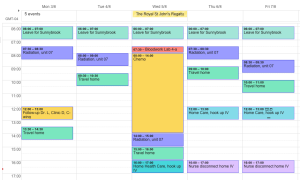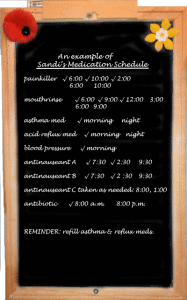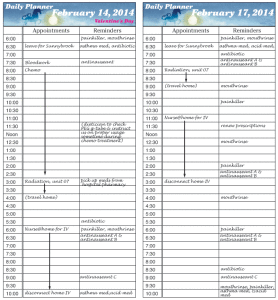Once I’d been diagnosed with throat cancer and treatments were about to start, a good friend of mine passed along a valuable piece of advice to us: get organized before treatment starts.
I’m very glad we listened to her. There were a great deal of appointments to keep track of and medications that needed to be taken on various schedules. I had no idea of just how much of both there would be. Neither one of us was in the proper frame of mind to remember all that needed to be done, so we used common tools to help us stay on top of everything.
Let’s start with keeping track of appointments. Your appointments may be very different from mine, but for my throat cancer I had appointments for:
- radiation pre-planning
- daily radiation treatments
- chemo treatments every few weeks
- blood tests
- special radiation dentist
- home health visitations for hydration
- weekly PICC line flushing
- weekly clinic appointments with radiation oncologist
- weekly clinic appointments with chemo oncologist
- diagnostic tests (ongoing CT scans and scopes and the like)
- dietician
- swallowing/speech therapist
- social worker/therapist
- occupational or rehabilitation therapist
- and probably more that I’m forgetting.
My husband and I found that using a shared online calendar, one that both of us could view and add appointments to, worked very nicely for us. We used an Outlook calendar (Microsoft), but if you have email then you may have access to an online calendar as well. Some will allow you to share your calendar with other email addresses, such as Rogers or Google (gmail.)

Enter all of your appointments into the calendar as they are scheduled so that you don’t forget any, and then you can tell at a glance if you’re being double-booked for different appointments. Some appointments are booked months in advance and some are booked with very little warning, so this really helped keep us on track. We couldn’t trust ourselves to remember every little thing. It also helped my husband schedule his own appointments around my treatment schedules (dentist and the like.)
Be sure to include the location specifics as part of your scheduled appointment so that you know where you’re going before you get there. For example, you should know the hospital/treatment centre address, wing or section, floor, room number, etc, and add the person’s name you’re supposed to see if you know it as well.
If your travel time is substantial then you should include that in your schedule so that you don’t accidentally schedule a nursing home visit while you’re still on the road. You may want to pad in some extra time in case your appointments run late or you run into traffic.
Sunnybrook has an online patient health resource that shows you your scheduled appointments. It’s really a great tool, but you’ll need something that will show all appointments, not just the ones at the hospital.
You’ll also need to keep track of medication schedules. It wasn’t just appointments that I had to keep track of, there were also a myriad of medications that needed to be taken at specific times during the day, and also for specific periods of time after chemo sessions. Your medications may be very different from mine, but for my throat cancer here’s what I needed to keep track of:
- 4 different anti-nauseants, one to be taken as needed, one to be taken prior to chemo, one to be taken for 2 days following chemo, and the last to be taken for 3 days following chemo, all at different times of the day
- 5 different antibiotics
- 3 different painkillers, one to be taken 3 times daily, one to be taken morning and evening, and the other as needed, except on chemo days
- “magic mouthwash”, a combo lidocaine (painkiller for throat) & anti-thrush med to gargle with
- 2 different magnesium supplements
- potassium supplement
- hypertension medication
- asthma medication
For this we used a simple chalkboard in the kitchen. We drew a grid on the chalkboard listing the meds and the day’s schedule listing the times that I would need to take each medication. As I took each med according to the appointed time we would put a tick mark beside it. We wouldn’t erase the meds or the schedule because at the end of the day, before bed time, we would reset the board. We’d simply remove the tick marks so that it would be ready to go again the next morning.

A whiteboard would work just as well, or for that matter so would a spreadsheet such as Excel, or a piece of paper. If you use paper, write the meds along with scheduled times in ink and then use a pencil to tick them off. At the end of the day, erase the pencil marks leaving the inked medication info intact. Just ensure that whatever tracking method you use, it’s accessible to everyone who may need to administer your medication in case the primary caregiver isn’t around.
A daily planner with multiple columns would allow you to keep track of both appointments and medications. If you use a paper daily planner then the downside to this is that you would have to copy your medication schedule into each day, instead of just “resetting” your existing schedule.

One last word of advice from me on this: be diligent in keeping your appointment schedule and medication tracking up to date as you go. It really will save a lot of headache and confusion when the going gets tough.
—Sandi
Next post: The Oncology Team.
Your list of medications and appointments was quite a lot, so great suggestions on how to keep everything organized! That’s project management at its best, for the worst of times.